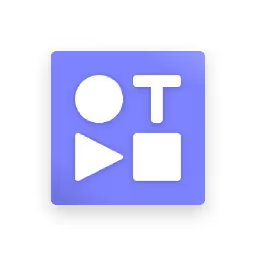Saleo Alternatives
Considering a switch from Saleo? Here are 10 alternatives. We provide a detailed comparison of demo automation tools to inform your decision.

Saleo is a popular tool for a reason. Many teams use it to build live, data-driven product demos. It does a great job creating realistic and engaging experiences for prospects, which helps sales teams show their product's value.
But like any tool, it has limits. Some users note its learning curve or specific feature gaps. We've analyzed the best alternatives based on G2 reviews, comparing their pros and cons to help you find the right fit. Let's get started.
11x: Digital Workers for Sales
For teams exploring digital workers to support sales efforts, consider 11x. The platform offers autonomous agents designed to manage specific sales functions.
This approach can free up your representatives to concentrate on higher-value activities and interactions with potential customers.
11x is a GTM platform that uses AI agents to manage the sales process autonomously. Its agent, Alice, finds high-intent prospects, handles outreach on email and LinkedIn, and updates your CRM. Julian, another agent, qualifies inbound leads and books meetings. The platform consolidates functions like data enrichment, outreach, and email warmup, so separate tools are not needed.
Saleo Alternatives
The following section analyzes each alternative in detail. We cover pricing, core features, and the main advantages and potential drawbacks of each tool when compared to Saleo.
1) Reprise

Reprise is a demo creation platform for presales, sales, and marketing teams. Its AI builds and maintains interactive demo environments to help shorten sales cycles and reduce live demo costs. The platform supports live sales calls, website product tours, and sales leave-behinds.
It also provides sandbox environments for prospects and offline demos for events like tradeshows.
Reprise's Main Features
- Auto-configures, populates, and maintains demo environments using AI-generated custom data sets for specific storytelling.
- Offers three demo modes: guided product tours (Reprise Replay™), live app overlays (Reprise Reveal™), and full application clones (Reprise Replicate™).
- Provides deep customization options, allowing edits down to the code level for elements like graphs, charts, and text flows.
- Includes enterprise-grade security with role-based access controls, SSO, and GDPR, SOC 2, and ISO certifications.
How Reprise Compares to Saleo
Average Review score: 4.4/5 stars based on 162 G2 reviews.
- Reprise offers three different demo modes: guided tours, live overlays, and full application clones. This provides more variety for sales and marketing teams compared to Saleo's focus on live, data-driven demos.
- It allows for deep customization, including editing at the code level for elements like charts and text. This gives users more granular control over the demo environment than Saleo might offer.
- The tool provides sandbox environments, which let prospects explore a product on their own. This is a different use case from the live, guided demos that are central to Saleo.
- Its AI can generate complete, custom data sets to build a demo environment for a specific story. This approach to data population is more extensive than editing single data points in a live setting.
Potential Drawbacks Compared to Saleo
- Some users find Reprise has a steep learning curve, particularly when they create full application clones. The setup process can take more time compared to Saleo's focus on live data editing.
- The tool's strength is in creating captured or cloned versions of an application. For teams that need to edit data in a live product during a demo, Saleo offers a more direct solution.
- Maintaining cloned demos can be a challenge for some. When the main product updates, the Reprise demo may also need a manual update, which is less of a concern with Saleo's live overlay model.
Cost and Value Analysis
Reprise does not publish its pricing, but user reviews indicate a high perceived cost. Since both platforms often serve enterprise clients, pricing is likely customized based on specific needs. For the most accurate information, we recommend visiting Reprise's official website to request a quote.
2) Demostack
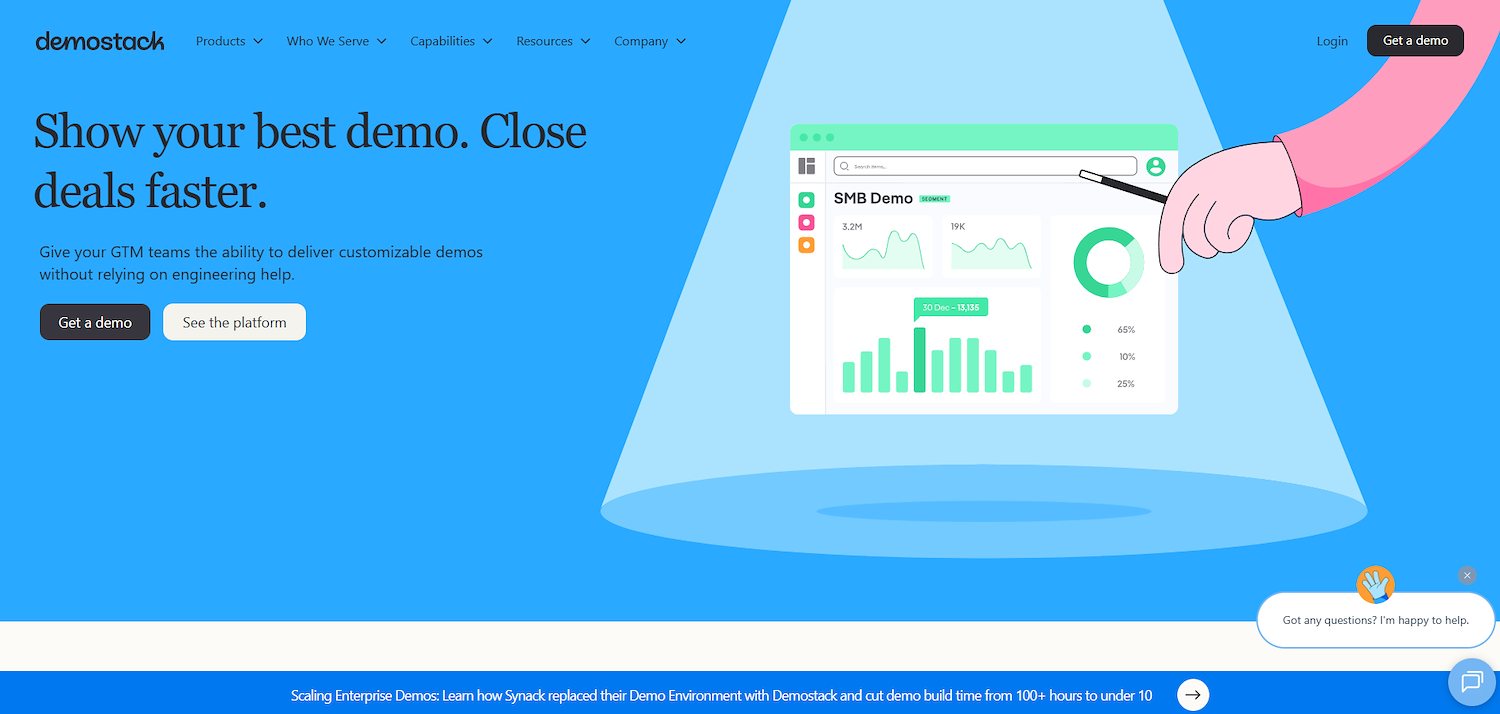
Demostack is a demo experience platform for go-to-market teams at software companies. It allows staff to build and deliver customized product demos without engineering support. The platform creates clickable tours, live demos, and interactive sandboxes that mirror the real product.
Teams use these assets for marketing campaigns, live sales presentations, and post-call follow-ups. The goal is to shorten sales cycles and increase win rates.
Demostack's Main Features
- Captures and edits product screens to create demos without engineering support.
- Offers three demo formats out of the box: clickable product tours, live demos, and customizable sandboxes.
- Provides analytics to measure demo performance and guide continuous optimization.
- Includes enterprise capabilities such as SOC 2 compliance, a scalable architecture, and integrations with Salesforce and Slack.
How Demostack Compares to Saleo
Average Review score: 4.7/5 stars based on 72 G2 reviews.
- Demostack creates a complete, separate clone of your product's front end. This provides a stable demo environment that is free from bugs, which is different from Saleo's live overlay approach.
- It offers multiple demo formats, including clickable tours and sandboxes for prospects. This gives teams more flexibility for marketing and follow-ups compared to Saleo's focus on live sales demos.
- The tool provides analytics on demo engagement. This feature allows teams to see how prospects interact with the content, offering insights that are not a primary feature of Saleo.
- Users can edit the cloned demo with a point-and-click editor that includes find-and-replace functions. This method of customization is different from Saleo, where users edit data points in a live setting.
Potential Drawbacks Compared to Saleo
- Demostack creates a front-end clone, which can become outdated. Some users note that when the main product updates, the demo clone needs a complete rebuild. Saleo works directly on the live product, so it always shows the latest version.
- The tool is less flexible for spontaneous changes during a live demo. Saleo allows reps to edit data points in real time, but Demostack's cloned environment works best with pre-planned scenarios and may not handle unexpected clicks well.
- Its cloned demos sometimes require significant maintenance. If the main product changes, users may need to recreate the demo from scratch. Saleo's overlay model avoids this issue as it works on the live application, which simplifies upkeep.
Cost and Value Analysis
Demostack does not publish its pricing, but user reviews indicate a high perceived cost. Both platforms typically serve enterprise clients, so pricing is likely customized. For the most accurate information, we recommend visiting Demostack's official website to request a quote.
3) Navattic
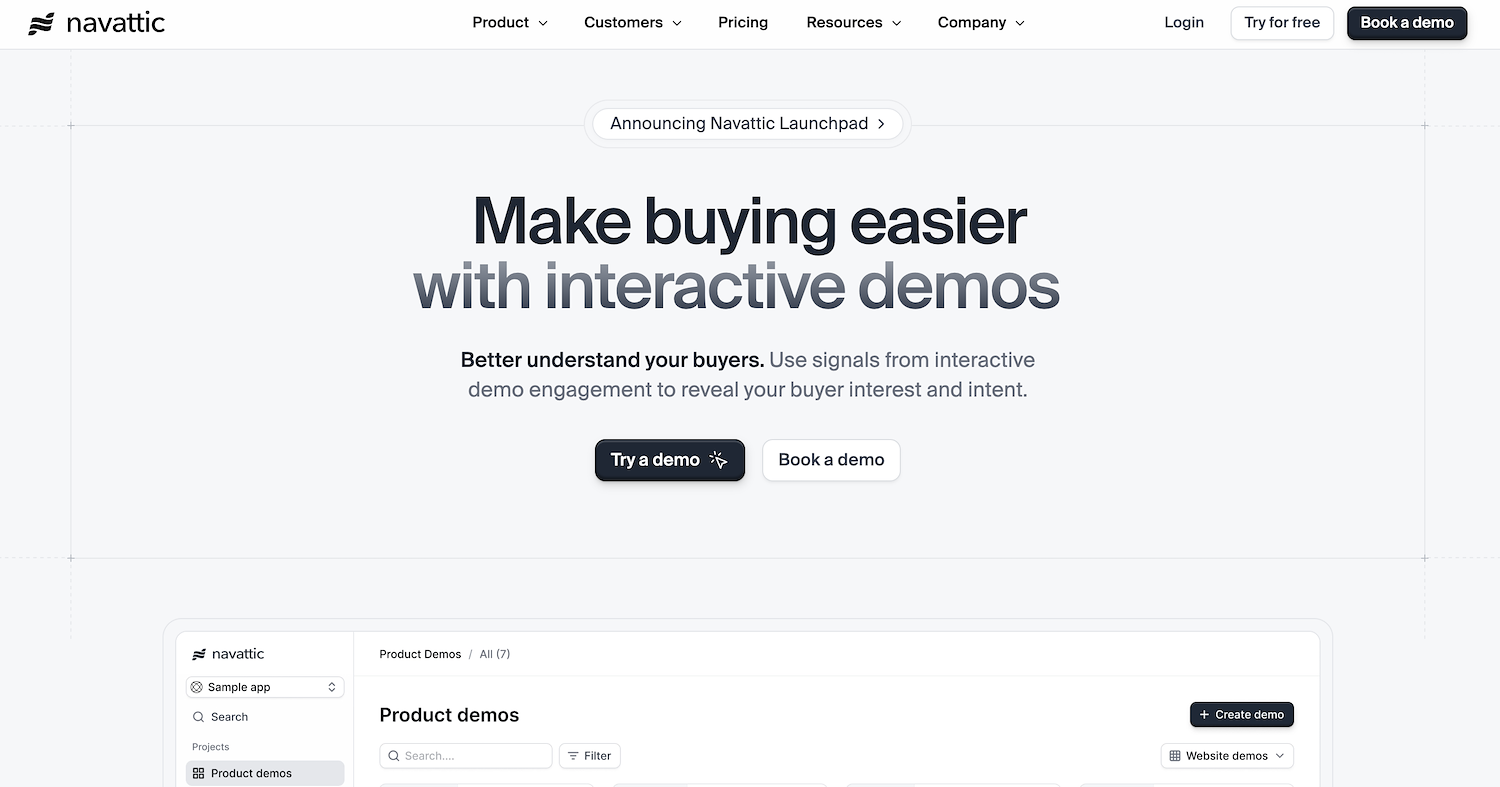
Navattic is an interactive product-demo platform. It lets go-to-market teams embed no-code, clickable demos across the buyer journey. The tool captures engagement signals like time spent and steps viewed to reveal prospect intent.
Use cases include website lead capture, sales leave-behinds, and event demos. Companies that use the platform report higher website conversion rates.
Navattic's Main Features
- Builds no-code, interactive product tours that can be hosted and shared without engineering help.
- Routes visitors to a demo tailored to their choices and inserts dynamic variables for personalized content.
- Translates and distributes demos for global use and allows downloads for offline events like trade shows.
- Includes pre-built playbooks that surface buyer activity through email and Slack alerts or advanced filtering.
How Navattic Compares to Saleo
Average Review score: 4.8/5 stars based on 448 G2 reviews.
- Navattic tracks how prospects engage with demos and sends alerts for high-intent views. This offers more insight into buyer interest compared to Saleo's live-only demo focus.
- It allows marketing teams to embed interactive product tours on a website. This serves a different purpose than Saleo, which is designed primarily for live sales presentations.
- The platform uses branching logic to create custom demo flows for different user segments. This provides a more tailored, self-serve experience than the rep-led demos common with Saleo.
- Its demos can be downloaded for offline use at events like trade shows. This provides flexibility that is not available with Saleo's live, internet-dependent overlay.
Potential Drawbacks Compared to Saleo
- Navattic's demos are based on captured screens, so they can become outdated when the main product updates. In contrast, Saleo operates on the live product, which ensures the demo always shows the latest version.
- The platform is less flexible for on-the-fly changes during a live presentation. Saleo allows reps to modify data in real time, which is useful for answering unexpected prospect questions.
- Some users note that keeping captured demos current requires manual updates after the main product changes. Saleo's live overlay model avoids this maintenance because it works directly on the live application.
Cost and Value Analysis
Navattic offers transparent pricing with a free starter plan and paid tiers starting at $500 per month, making it accessible for various teams. In contrast, Saleo does not publish its pricing, suggesting a custom model geared toward enterprise clients. For detailed pricing, visit Navattic's official website.
4) Walnut
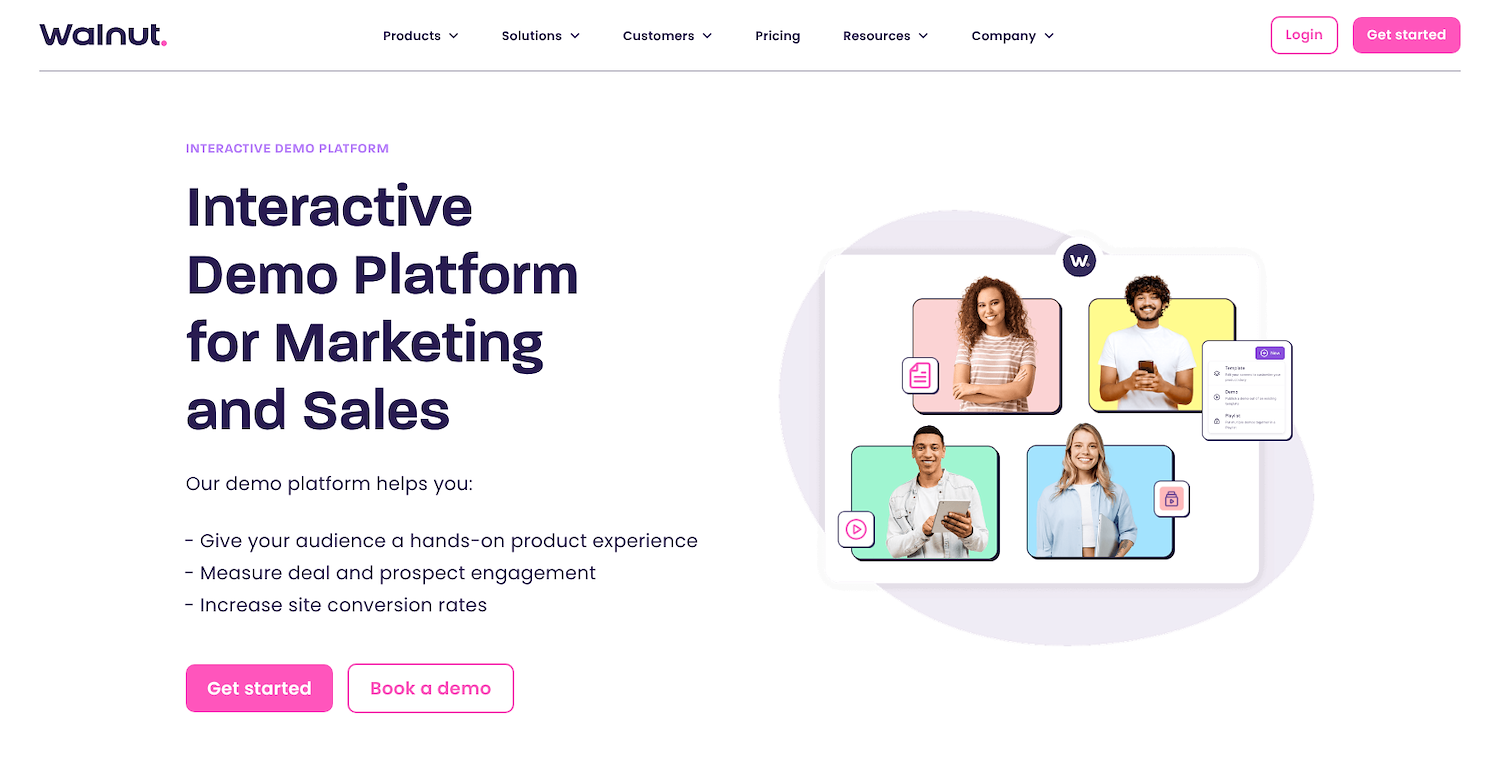
Walnut is a no-code platform for go-to-market teams to create interactive product demos. It lets sales teams personalize the demo experience for each prospect without code.
Use cases include live sales demos, website product tours, and user education for customer success. The platform aims to shorten sales cycles and improve conversion rates.
Walnut's Main Features
- Captures your product once to create clickable, guided demos or self-guided tours that can be personalized at scale.
- Hosts interactive deal rooms that bundle demos, collateral, and mutual action plans into a single destination.
- Tracks demo views, step completion, and time on page to provide data-backed insights into buyer engagement.
- Offers native connectors for tools like Salesforce, HubSpot, and Slack to support existing workflows.
How Walnut Compares to Saleo
Average Review score: 4.5/5 stars based on 104 G2 reviews.
- Walnut provides analytics on demo engagement, such as views and completion rates. This offers insights into buyer interest that are not a primary feature of Saleo's live-only format.
- It hosts interactive deal rooms that bundle demos and other sales materials into one place for prospects. This is a broader function compared to Saleo's focus on the live demo itself.
- The platform allows teams to embed interactive product tours on websites or in emails. This supports marketing use cases, while Saleo is designed primarily for live sales calls.
- Demos are built from a capture of your product, which creates a stable, bug-free experience. This differs from Saleo's live overlay, which works on the actual product and can be subject to its instability.
Potential Drawbacks Compared to Saleo
- Walnut creates demos with a capture of your product's front end. This means if your main product updates, the demo might not reflect the changes until you recapture it. In comparison, Saleo's live overlay always shows the current product version.
- It can be difficult to make spontaneous changes during a live demo. Since demos are pre-captured, reps cannot always adjust data points in real time to answer unexpected questions, a feature that is central to Saleo.
- The tool's captured demos may require manual updates to stay current with product changes. Some users find this creates extra work. In contrast, Saleo's live overlay model does not have this issue because it operates directly on the live application.
Cost and Value Analysis
Walnut offers transparent pricing, with its Ignite plan at $750.02 per year for three editor seats. In contrast, Saleo does not publish its pricing, suggesting a custom model for enterprise clients. This makes Walnut accessible for teams needing predictable costs, while Saleo likely serves large, custom deployments.
5) Storylane
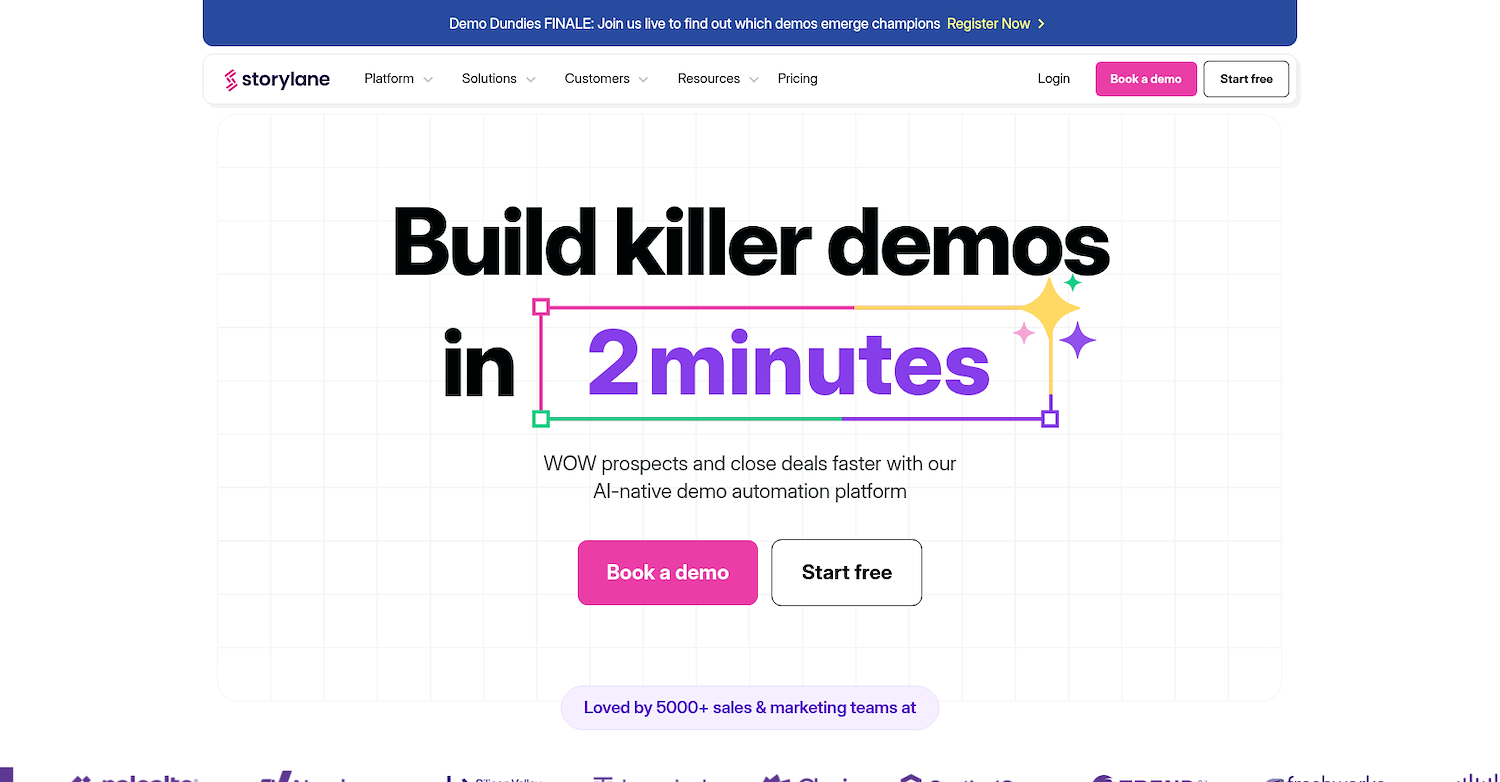
Storylane is a platform for go-to-market teams to create interactive product demos. Companies use it for live sales presentations, website lead generation, and partner enablement. The tool allows prospects to experience the product firsthand, which can help accelerate sales cycles.
Storylane's Main Features
- Generates walkthrough text, voice-overs, and video avatars automatically using an AI agent named Lily.
- Offers a Buyer Hub, which is a centralized deal room for sellers to collect all necessary assets for a buyer.
- Tracks demo engagement, de-anonymizes visitors with an Account Reveal feature, and syncs data back to a CRM.
- Captures front-end screens with a browser extension to clone the product and stitch together user flows.
How Storylane Compares to Saleo
Average Review score: 4.8/5 stars based on 771 G2 reviews.
- Storylane uses an AI agent to automatically generate demo text and voice-overs. This automates content creation, unlike Saleo, which requires reps to guide the entire demo manually in a live session.
- The platform tracks how prospects interact with a demo and can reveal anonymous visitor identities. This provides sales teams with engagement data that is not a core part of Saleo's live demo functionality.
- It offers a Buyer Hub, a central space for all deal-related materials like demos and documents. This is a broader sales enablement feature compared to Saleo's specific focus on the live product demonstration.
- This tool allows marketing teams to embed interactive tours on a website for lead generation. This serves a different top-of-funnel purpose than Saleo, which is designed primarily for live sales conversations.
Potential Drawbacks Compared to Saleo
- Storylane builds demos from captured screens, which can become outdated. In contrast, Saleo works on the live product, so it always reflects the most current version without extra work.
- The platform is less suited for spontaneous changes during a live demo. A sales rep cannot easily adjust data points in real time, a core feature of Saleo that helps answer unexpected prospect questions.
- Some users note that captured demos require manual updates to stay current after the main product changes. Saleo's live overlay model avoids this issue because it operates directly on the live application.
Cost and Value Analysis
Storylane offers transparent pricing, with a Starter plan at $50 per month for one user. In contrast, Saleo does not publish its pricing, suggesting a custom model geared toward enterprise clients. This makes Storylane a more accessible option for teams needing predictable costs, while Saleo is likely better suited for large organizations with specific deployment needs.
Consider 11x for Your Sales Team
If your team has an interest in digital workers for sales, 11x provides autonomous agents. These agents manage outreach and lead qualification. This lets your sales staff focus on high-value interactions. Visit their website to see if this approach fits your team's needs.
With 11x, we use AI to run your sales playbook. Our agent Alice finds accounts and manages outreach, while Julian qualifies leads and schedules meetings. The platform consolidates data, outreach, and email warmup, so you do not need separate tools.
Book a demo to see it in action.
6) Tourial
Tourial is a platform for creating interactive product tours. It helps marketing and sales teams guide buyers through a product's story. The tool is used to build self-guided demos that can be embedded on websites or shared in campaigns to generate and qualify leads.
Tourial's Main Features
- Builds interactive, self-guided product tours with a no-code editor.
- Integrates lead capture forms directly within the tour to convert viewers.
- Provides analytics on tour engagement, including views, completion rates, and user paths.
- Supports integrations with CRMs like Salesforce and HubSpot to sync lead data.
How Tourial Compares to Saleo
Average Review score: 4.7/5 stars based on 289 G2 reviews.
- Tourial focuses on creating self-guided, interactive product tours for marketing. This contrasts with Saleo, which is designed for live, rep-led sales demos.
- It includes built-in lead capture forms and detailed analytics on viewer engagement. These features support top-of-funnel activities, which are not Saleo's primary use case.
- The platform builds tours from screen captures, creating a controlled, bug-free environment. Saleo operates as a live overlay on the actual product.
- Its main goal is to generate and qualify leads through asynchronous experiences. Saleo's purpose is to empower sales reps during synchronous conversations.
Potential Drawbacks Compared to Saleo
- Since Tourial uses screen captures, demos can become outdated when the product updates. Saleo works on the live product, so it always shows the current version.
- The platform is not built for real-time customization during a live sales call. Saleo allows reps to change data on the fly to answer specific prospect questions.
- Some teams may find that maintaining captured tours requires effort. If the product's UI changes, the tour may need to be rebuilt to stay accurate.
Cost and Value Analysis
Tourial does not publish its pricing, which suggests a custom model based on usage and features. Like Saleo, it likely serves mid-market and enterprise clients with tailored packages. For accurate pricing, it is best to contact Tourial for a quote.
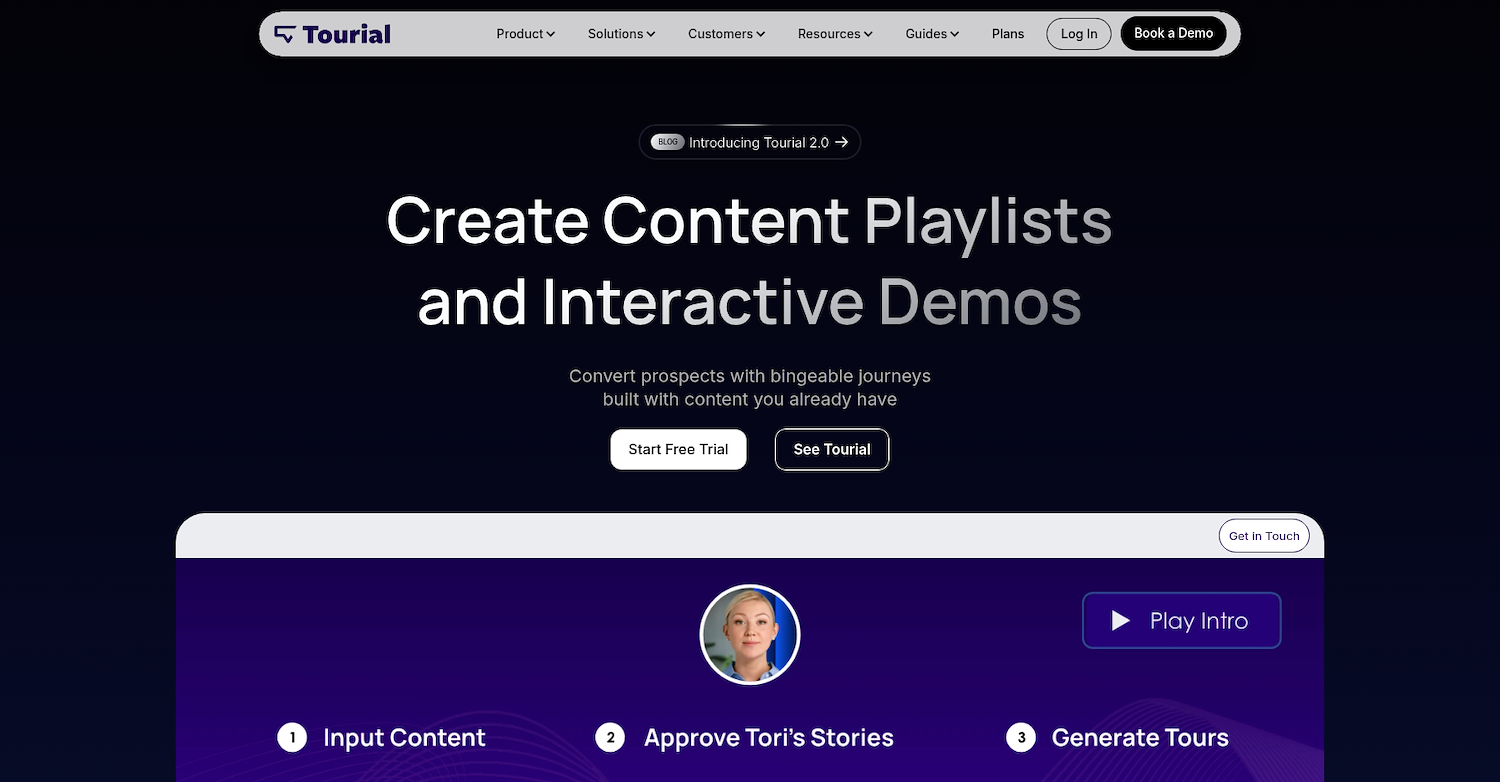
Tourial is a platform for marketing and sales teams to build interactive, self-guided product tours. These demos guide buyers through a product story and can be embedded on websites or shared in campaigns to generate and qualify leads.
Tourial's Main Features
- Uses AI to assist with planning and building interactive micro tours, including the automated generation of tour copy and structure.
- Provides centralized tour centers where visitors can browse collections of tours tailored to their persona, use case, or industry.
- Records product screens, workflows, and click-paths with a Chrome extension to create demo sequences quickly.
- Syncs calls-to-action and engagement data into marketing and sales stacks through native integrations and custom scripts.
How Tourial Compares to Saleo
Average Review score: 4.6/5 stars based on 83 G2 reviews.
- Tourial builds self-guided product tours that can be embedded on websites. This serves top-of-funnel marketing, which is different from Saleo's focus on live sales demos.
- It provides analytics on tour engagement and syncs this data to a CRM. This gives teams insights into buyer behavior, a feature not central to Saleo's live format.
- The platform offers centralized tour centers where prospects can browse collections of demos. This provides a broader content experience compared to Saleo's single, live demo instance.
- Its demos are built from screen captures, which creates a stable, controlled experience for the user. This contrasts with Saleo's live overlay, which works on the actual product.
Potential Drawbacks Compared to Saleo
- Tourial is not built for real-time customization during a live sales call. A sales representative cannot alter data points on the fly, which is a core feature of Saleo for answering unexpected prospect questions.
- Its demos are based on screen captures, which can become outdated. Some users note that when the main product updates, the tour may need to be rebuilt, an issue Saleo's live overlay model avoids.
- A captured demo might not convey the true performance of the live product. Prospects interact with a controlled copy, whereas Saleo provides an experience within the actual application, which can feel more authentic.
Cost and Value Analysis
Tourial does not publish its pricing, but user reviews indicate a high perceived cost, suggesting a custom model. This approach is similar to Saleo's, as both platforms likely offer tailored packages for enterprise clients. For the most accurate pricing, we recommend visiting Tourial's official website.
7) TestBox
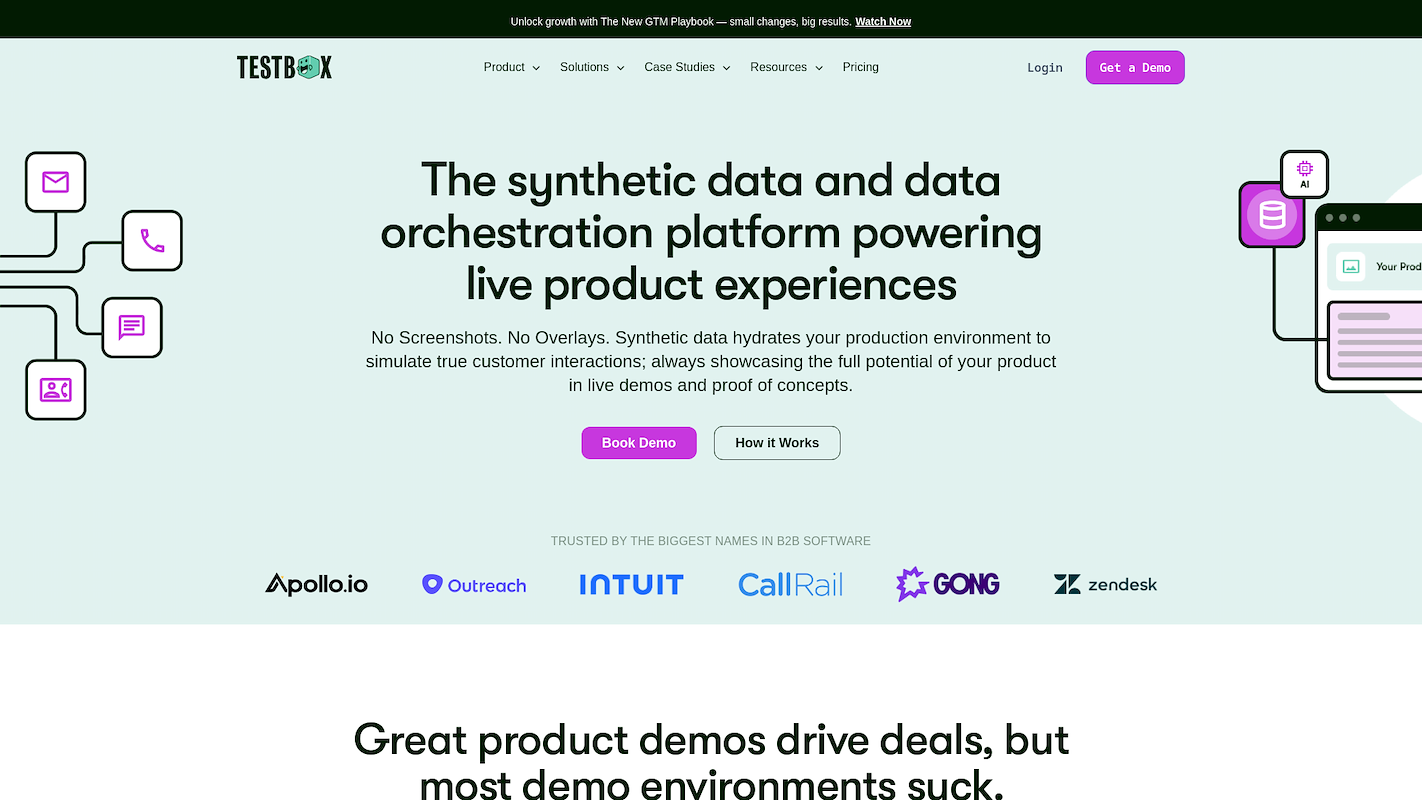
TestBox is a platform for B2B software buyers. It lets teams test-drive multiple products in live, pre-configured sandboxes. Users can compare software side-by-side in a private environment before they make a purchase.
This approach helps with software evaluation and proof-of-concept exercises without the typical setup delays from individual vendors.
TestBox's Main Features
- Generates synthetic, multi-layered datasets that mimic customer interactions and are PII-free.
- Automatically populates and refreshes data so demos always reflect the latest product state.
- Displays third-party integrations like CRM and email working in real time from a single interface.
- Spins up a proof-of-concept directly from the demo environment to let buyers test the product themselves.
How TestBox Compares to Saleo
Average Review score: 4.8/5 stars based on 100 G2 reviews.
- TestBox injects AI-generated data directly into a live product instance. This approach provides a more authentic experience for complex features compared to Saleo, which uses a data overlay on the front end.
- It offers scalable proof-of-concept (POC) environments. This allows prospects to test the product independently, a feature not central to Saleo's model for representative-led demos.
- The tool is built to showcase advanced functions like AI and third-party integrations in a live setting. In comparison, Saleo's overlay may have some limits when demonstrating features that depend on backend processes.
- TestBox provides pre-configured demo environments that are always ready. This can reduce the setup time for sales teams compared to preparing a live demo with Saleo before each presentation.
Potential Drawbacks Compared to Saleo
- TestBox focuses on injecting data into a live product, which is different from Saleo's front-end overlay. Some users might find Saleo's approach more direct for making quick cosmetic changes to text or graphs during a live presentation.
- The tool is designed around pre-configured environments with synthetic data. This setup sometimes makes it less flexible for spontaneous data changes during a live demo, a core feature of Saleo that allows reps to answer unexpected questions.
- Its strength is in creating full proof-of-concept environments for prospects to test on their own. For teams that only need to edit data in a live, rep-led demo, Saleo offers a more focused and direct tool.
Cost and Value Analysis
TestBox does not publish its pricing, but user reviews indicate a high perceived cost. This custom approach is similar to Saleo's, as both platforms likely offer tailored packages for enterprise clients. For the most accurate pricing, we recommend visiting TestBox's official website.
8) Supademo
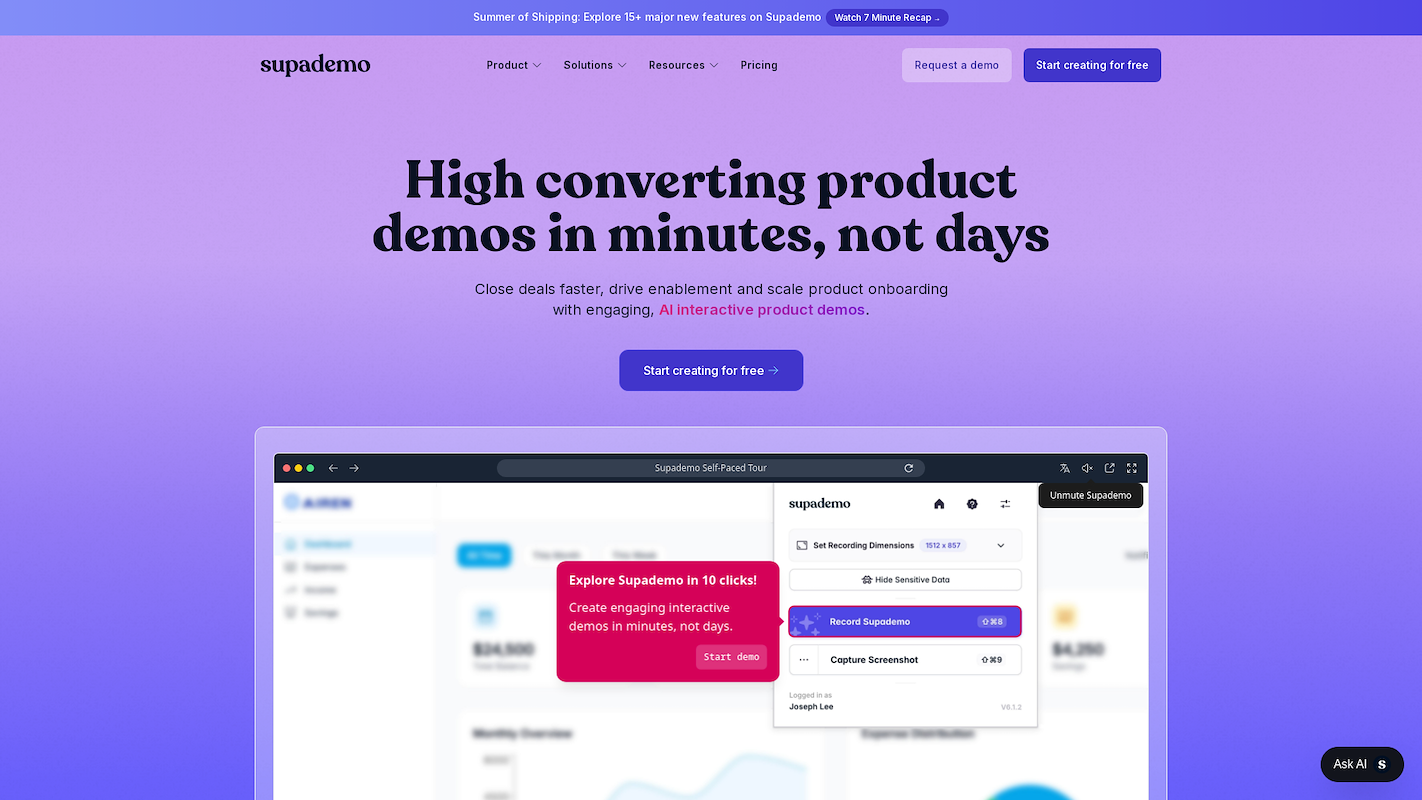
Supademo is a platform to create interactive product demos. It allows teams to build step-by-step demonstrations of their software. These demos support use cases that include customer onboarding, employee training, and sales enablement. The tool helps users create guided tours that can be shared via a link.
Supademo's Main Features
- Uses AI to auto-generate hotspot text, apply voiceovers, and translate content into multiple languages.
- Repurposes a single recording into an interactive demo, video, GIF, or standard operating procedure guide.
- Personalizes demos at scale using dynamic variables, custom domains, and conditional branching logic.
- Groups multiple interactive demos into a showcase collection or demo center for prospects to browse.
How Supademo Compares to Saleo
Average Review score: 4.7/5 stars based on 362 G2 reviews.
- Supademo uses AI to automatically generate text and voiceovers for demos. This is different from Saleo, where a sales representative manually guides the entire presentation.
- It allows teams to repurpose one recording into multiple formats like interactive demos, videos, or guides. Saleo, in comparison, focuses only on creating live demo experiences.
- The tool personalizes demos at scale with features like dynamic variables and branching logic for self-guided tours. This approach differs from Saleo, where personalization happens in real-time during a live call.
- The platform lets users group multiple demos into a showcase or demo center for prospects to explore. This provides a broader content library, unlike Saleo's focus on single, live demo sessions.
Potential Drawbacks Compared to Saleo
- Supademo is not designed for real-time changes during a live sales call. A sales representative cannot alter data points on the fly, a core feature of Saleo used to answer unexpected prospect questions.
- Its demos are based on screen captures, which can become outdated when the main product updates. Saleo works on the live product, so it always shows the current version without extra work.
- A captured demo might not convey the true performance of the live product. Prospects interact with a controlled copy, whereas Saleo provides an experience within the actual application, which can feel more authentic.
Cost and Value Analysis
Supademo offers transparent pricing with a free plan and paid tiers starting at $27 per month. This makes it an accessible option for teams with predictable budgets, while Saleo's unpublished pricing points to a custom model for enterprise clients.
9) Consensus
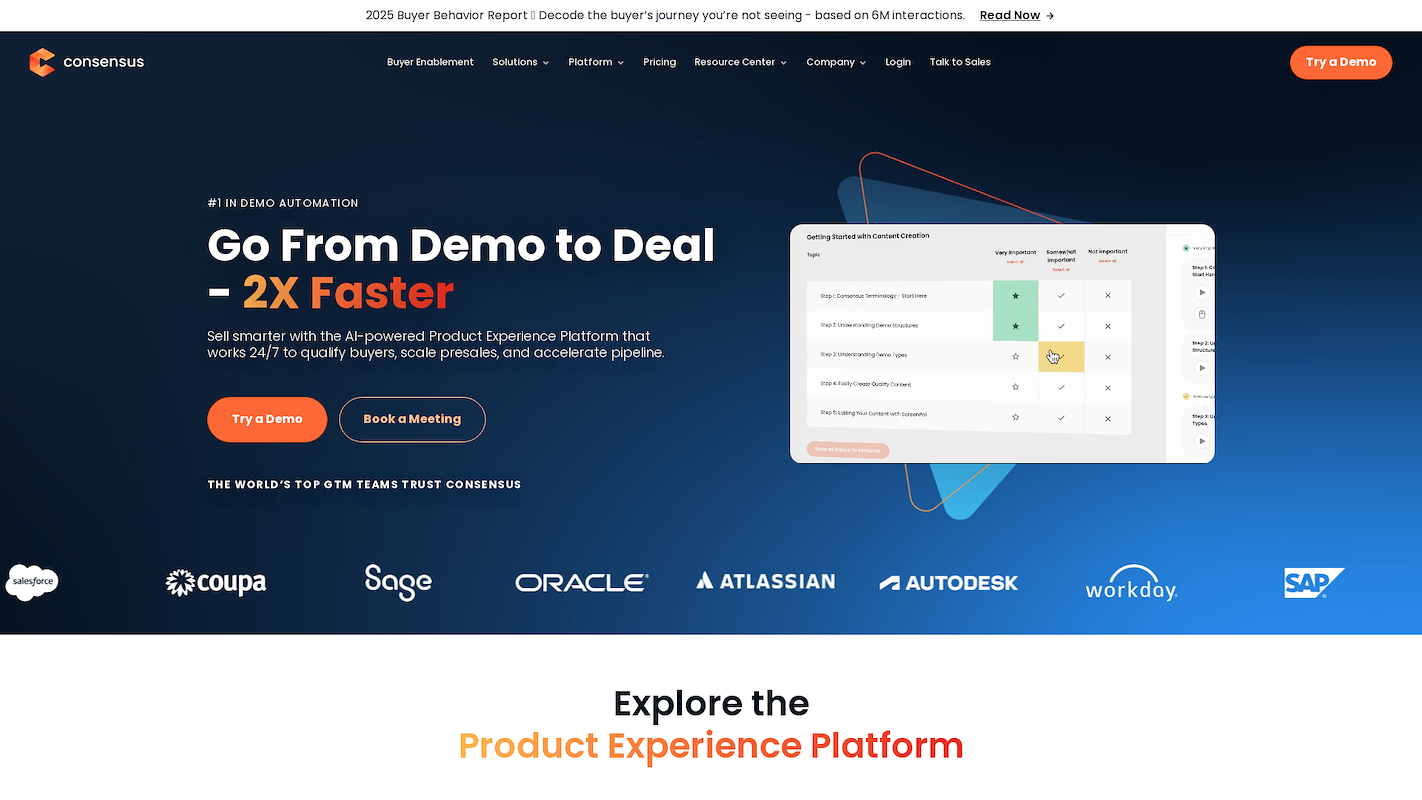
Consensus is a demo automation platform for presales and technical sales teams. It creates interactive video demos that buyers can watch on demand. This approach lets prospects explore a product and share it with colleagues. The platform tracks viewer engagement to discover and qualify stakeholders inside a buyer's organization.
It helps sales teams automate standard demos so they can focus on more complex customer conversations and technical deep dives.
Consensus's Main Features
- Combines video demos, product tours, and simulated environments using patented demo automation technology.
- Adapts demos to each viewer, creating personalized experiences that answer key questions automatically.
- Tracks viewer engagement to reveal hidden stakeholders and provides data on buyer intent with every click.
- Uses generative AI to assist with content creation, including AI-powered text generation.
How Consensus Compares to Saleo
Average Review score: 4.8/5 stars based on 1,004 G2 reviews.
- Consensus automates the creation of on-demand, interactive video demos that adapt to each viewer. This is different from Saleo, which focuses on enabling real-time data edits during a live presentation.
- The platform tracks viewer engagement to identify all stakeholders in a buying group. This provides buyer intent data that is not a core function of Saleo's live-only demo format.
- It uses generative AI to assist with creating demo content, such as text. This approach automates some of the setup, while Saleo requires the sales representative to guide the entire demo manually.
- This tool allows prospects to watch demos on their own time. This asynchronous model helps scale presales efforts, whereas Saleo is built for synchronous, rep-led conversations.
Potential Drawbacks Compared to Saleo
- Consensus is designed for on-demand video demos, so it lacks real-time editing capabilities. Unlike Saleo, a sales representative cannot change data points live to answer a prospect's spontaneous questions during a presentation.
- The platform uses interactive video and simulations, which may not always show the true performance of a live product. In comparison, Saleo operates as an overlay on the actual application, which provides a more authentic user experience.
- Its focus is on asynchronous demos that buyers watch alone. This makes it less direct for sales representatives who need to customize a presentation during a live conversation, a situation where Saleo provides more control.
Cost and Value Analysis
Consensus does not publish its pricing, but user reviews indicate a high perceived cost. This custom approach is similar to Saleo's, as both platforms likely offer tailored packages for enterprise clients. For the most accurate pricing, we recommend visiting Consensus's official website to request a quote.
10) Tiled
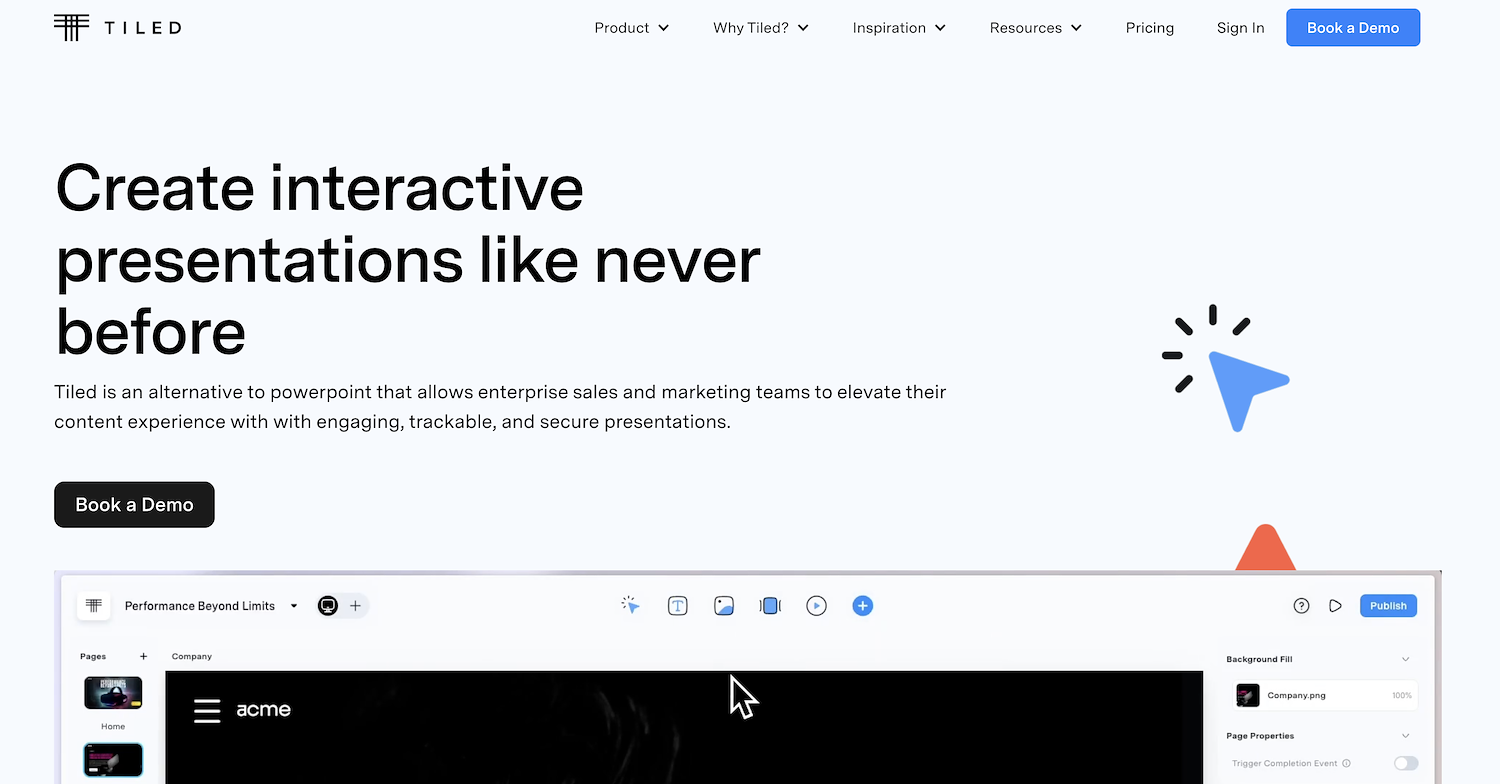
Tiled is an interactive content platform for teams to build and share experiences, called microapps, without code. It transforms static assets into interactive content. Use cases cover sales enablement, marketing, and employee communications.
Teams use the platform to create presentations, proposals, and training materials. The system measures user engagement to provide insights on how the content performs.
Tiled's Main Features
- Manages, imports, and creates content using templates and slide design tools.
- Includes analytics, reporting, and alerts for tracking account-based engagement.
- Enables live and mobile presentations with built-in presenter tools.
How Tiled Compares to Saleo
Average Review score: 4.3/5 stars based on 222 G2 reviews.
- Tiled transforms static assets like presentations and proposals into interactive content. This is different from Saleo, which focuses on editing data within a live product.
- It supports a wide range of materials beyond sales demos, including employee training and marketing content. In comparison, Saleo is built specifically for live sales presentations.
- The platform provides analytics on content engagement to show how prospects interact with materials. This offers insights that are not a primary feature of Saleo's live demo format.
- This tool creates content that prospects can view on their own time, such as interactive proposals. This serves a different need than Saleo, which is designed for real-time, representative-led demos.
Potential Drawbacks Compared to Saleo
- Tiled is not designed for real-time data editing within a live product. In comparison, Saleo allows representatives to change data points on the fly, which helps address specific prospect questions during a call.
- The platform's interactive content is built from static assets, so it may not convey the true performance of a live application. Saleo operates directly on the product, which provides a more authentic user experience.
- It is less suited for spontaneous demo customizations during a live conversation. With Saleo, a sales representative has the flexibility to alter the demo in real time to fit the discussion.
Cost and Value Analysis
Tiled does not publish its pricing, but user reviews indicate a high perceived cost. This custom approach is similar to Saleo's, as both platforms likely offer tailored packages for enterprise clients. For the most accurate pricing, we recommend visiting Tiled's official website.
Which One Should You Go With?
The choice of a Saleo alternative depends on many variables, from your specific use case to budget. This guide shared several options to help you make an informed decision.
If your team considers digital workers for sales, 11x offers autonomous agents to manage outreach and lead qualification. This approach allows your sales staff to focus on high-value interactions and closing deals.



